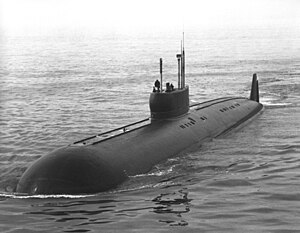 K-222 on the surface
| |
| Class overview | |
|---|---|
| Operators | |
| Preceded by | Charlie class |
| Succeeded by | Oscar class |
| Built | 1963–1970 |
| In commission | 1970–1988 |
| History | |
| Name | K-168 |
| Builder | Sevmash, Severodvinsk |
| Yard number | 501[1] |
| Laid down | 28 December 1963 |
| Launched | 21 December 1968 |
| Completed | 31 December 1969 |
| Commissioned | 1970 |
| Decommissioned | 1988 |
| Renamed | K-222 (15 January 1978) |
| Fate | Scrapped, 2010 |
| General characteristics | |
| Class and type | Papa-class cruise-missile submarine |
| Displacement | |
| Length | 106.92 m (350 ft 9 in) |
| Beam | 11.5 m (37 ft 9 in) |
| Draft | 8.2 m (26 ft 11 in) |
| Installed power |
|
| Propulsion | 2 × shafts; 2 × steam turbines |
| Speed |
|
| Endurance | 70 days |
| Test depth | 400 m (1,300 ft) |
| Complement | 82 |
| Sensors and processing systems | |
| Armament |
|
K-222 was the sole Project 661 "Anchar" (Cyrillic: Анчар) (NATO reporting name: Papa class) nuclear-powered cruise-missile submarine of the Soviet Navy during the Cold War. Although the Soviets saw K-222 as an unsuccessful design, upon completion it was the world's fastest submarine and the first to be built with a titanium hull.
The submarine was given several names over the course of its construction and service: she was originally designated K-18, named K-162 while under construction, and renamed to K-222 in 1978.
The Soviet government and Navy was dissatisfied with the Echo class of nuclear submarines, which had to surface to fire their missiles. In 1958 construction was authorized for an exceedingly ambitious program; the requirements called for a very fast boat equipped with missiles that could be launched while submerged. It accepted the preliminary design two years later and construction began in 1963; work proceeded very slowly as techniques for working titanium had to be developed and quality control was inconsistent. The program's objectives were generally satisfied, but the government had failed to include a requirement to minimize the submarine's acoustic signature which meant that K-222 was easily detectable at high speed. The Soviet Navy rejected a plan to place the design into series production as its flaws outweighed its advantages, but it pioneered the technology needed to work with titanium on a large scale, which enabled the subsequent construction of more successful designs using titanium, such as Projects 705 Lira, 945 Barrakuda, and 945A Kondor.
Commissioned in 1969, the-then K-162 was armed with 10 short-range, anti-ship cruise missiles and four torpedo tubes to carry out her mission of destroying American aircraft carriers. These missiles could be fitted with either conventional or nuclear warheads. The submarine served in the Soviet Red Banner Northern Fleet through the 1970s, but the discovery of hull cracks led to a lengthy repair period from 1972 to 1975. After an accident with K-222's nuclear reactor in 1980, the submarine went on her final operational patrol in 1981. She was removed from service in 1988 and scrapped in 2010.
- ^ "K-162 (6126349)". Miramar Ship Index. Retrieved 23 September 2009.